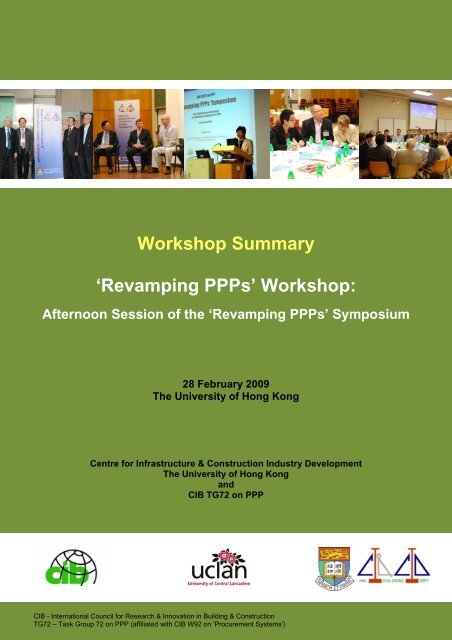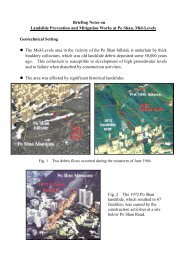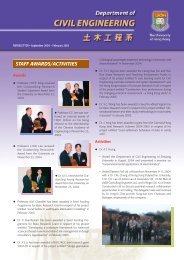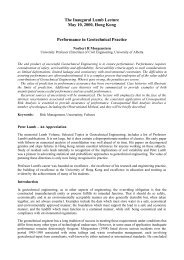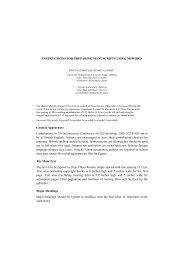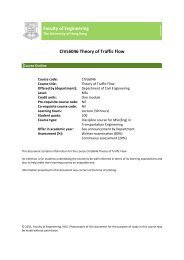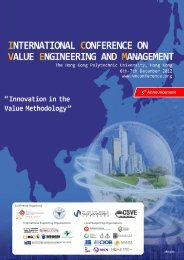Workshop Summary - Department of Civil Engineering - The ...
Workshop Summary - Department of Civil Engineering - The ...
Workshop Summary - Department of Civil Engineering - The ...
You also want an ePaper? Increase the reach of your titles
YUMPU automatically turns print PDFs into web optimized ePapers that Google loves.
<strong>Workshop</strong> <strong>Summary</strong>‘Revamping PPPs’ <strong>Workshop</strong>:Afternoon Session <strong>of</strong> the ‘Revamping PPPs’ Symposium28 February 2009<strong>The</strong> University <strong>of</strong> Hong KongCentre for Infrastructure & Construction Industry Development<strong>The</strong> University <strong>of</strong> Hong KongandCIB TG72 on PPPCIB - International Council for Research & Innovation in Building & ConstructionTG72 – Task Group 72 on PPP (affiliated with CIB W92 on ‘Procurement Systems’)
Table <strong>of</strong> ContentsPage1. WORKSHOP BACKGROUND 21.1 Objectives and Overview21.2 Participants’ Pr<strong>of</strong>ile21.3 Presentation <strong>of</strong> Position Papers21.4 Focus Group Discussions41.5 Consolidation Session52. GROUP OUTPUTS – STRATEGIES FOR REVAMPING PPPs 52.1 Stakeholder Management in PPPs and Sustainability Managementin PPPs52.2 PPP Structures, Systems & Mechanisms72.3 Risk Management in PPPs92.4 Selection <strong>of</strong> Partner Organizations & Key Personnel in PPPs93. FUTURE DIRECTIONS & POTENTIAL COLLABORATION 11APPENDIX 13Appendix I – ‘Revamping PPPs’ ‐ Seminar ProgrammeAppendix II – ‘Revamping PPPs’ ‐ <strong>Workshop</strong> Programme1314WORKSHOP REPORTING TEAM:Team Leader: James WongGroup Session Recorders: Ryan Fan, Terry Li, Lijuan Tao, James Wong, Kelwin WongTeam members: Akintola Akintoye, Jacky Chung, Mohan Kumaraswamy, Gangadhar Mahesh,James Wong, Kelwin Wong, Joe Zou1
1. WORKSHOP BACKGROUND1.1 Objectives and Overview<strong>The</strong> <strong>Workshop</strong> was held in the afternoon session <strong>of</strong> the ‘Revamping PPPs’ Symposium 2009(Symposium programme is attached in Appendices I & II). <strong>The</strong> morning Seminar set thestage by ‘revisiting and rethinking’ past PPPs with dissemination to over 200 participants.Indeed, the presentations, Q&A and Panel Discussion at the Seminar set the scene for agreater focus on ‘revamping and revitalising’ future PPPs in the afternoon <strong>Workshop</strong>.<strong>The</strong> <strong>Workshop</strong> then drilled deeper into core PPP concerns, comparing and synergising R&Don underpinning and emerging issues in order to formulate innovative strategies towardsmore effective and efficient PPP procurement and delivery. It was designed to revisit lessonslearned, and trigger fresh approaches and continuous improvements, alongside recentfinancial upheavals. <strong>The</strong> <strong>Workshop</strong> was also structured to mobilize strong inputs andfeedback from experts in public and private sectors and academia. It was divided into threesegments: i) Presentation <strong>of</strong> Position Papers; ii) Focus Group Discussions; and iii)Consolidation Session.1.2 Participants’ Pr<strong>of</strong>ile<strong>The</strong> <strong>Workshop</strong> brought together 53 experts with knowledge and interests in PPP(comprising 11 from government, 13 from consulting firms, 3 from contractor firms and 26from academia) along with 9 research students, totaling 62 participants. 17 <strong>of</strong> the workshopparticipants drew on recent PPP experiences from overseas including from Australia, Canada,Denmark, Greece, Malaysia, Singapore, South Africa, <strong>The</strong> Netherlands, the UK and USA.Five experts agreed in advance, to facilitate the group discussions and outputs, as well as tochair the preceding position paper presentations in their group sessions. <strong>The</strong> chairpersonfacilitatorswere (alphabetically):• Ir Bryan Clifford, JCP International• Dr Colin Duffield, <strong>The</strong> University <strong>of</strong> Melbourne• Ms Ada Fung, JP, Hong Kong Housing Authority• Ir Pr<strong>of</strong> C.K. Mak, JP, Development Bureau (Works)• Dr Arthur McInnis, Chinese University <strong>of</strong> Hong Kong<strong>The</strong> names <strong>of</strong> group members are not listed in this Report, since prior permission was notrequested, and while grateful for their inputs, neither they nor the facilitators areconsidered to be individually ‘responsible’ for the collective outputs, as presented herein.1.3 Presentation <strong>of</strong> Position PapersPrior to brainstorming in the focus groups, two presentations were given in each <strong>of</strong> the fourrooms where the focus group discussions were held. <strong>The</strong> presentations were based onsubmitted position papers, that are published in the Symposium Proceedings.<strong>The</strong> titles <strong>of</strong> the papers presented, authors and their affiliations were:2
i) Critical Success Factors for Knowledge Transfer in PFI projectsChampika Liyanage 1 , Taha Elhag 2 and Tabarak Ballal 31 University <strong>of</strong> Central Lancashire, UK2 University College London, UK3 University <strong>of</strong> Reading, UKii) Developing a Decision Support System for Concession Period DeterminationXueqing Zhang<strong>The</strong> Hong Kong University <strong>of</strong> Science and Technology, Hong Kongiii) PPPs and the Global Credit Crunch: What Next for the PPP Financial Model and GlobalGovernance?Peter RaisbeckFaculty <strong>of</strong> Architecture, Building and Planning, <strong>The</strong> University <strong>of</strong> Melbourne, Australiaiv) PPP’s as Temporary Project OrganisationsThomas Grisham 1 and Parthasarathy Srinivasan 21 Grisham Consulting Inc., St. Petersburg College, USA2 SRM Energy Pvt. Ltd., Spice Energy, Indiav) PPP in Denmark ‐ Is Strategic Partnerships Between the Public and Private Part a WayForward?Kristian KristiansenInstitute for Planning, Innovation and Management, Technical University <strong>of</strong> Denmark, Denmarkvi) Public Private Partnerships: A Strategic Partnering ApproachAthena Roumboutsos 1 and Nicola Chiara 21 <strong>Department</strong> <strong>of</strong> Shipping, Trade and Transport, University <strong>of</strong> the Aegean, Greece2 <strong>Department</strong> <strong>of</strong> <strong>Civil</strong> <strong>Engineering</strong>, Columbia University, USAvii) Revamping Public Private Partnerships (PPPs): A Systemic Approach through Establishmentand Management <strong>of</strong> Regional PPP Project Management Offices (PMOs)Josiah N Nyagwachi 1 , JJ Smallwood 2 and KD Hogan 31,3 <strong>Department</strong> <strong>of</strong> <strong>Civil</strong> <strong>Engineering</strong>, Nelson Mandela Metropolitan University, South Africa2 <strong>Department</strong> <strong>of</strong> Construction Management, Nelson Mandela Metropolitan University, South Africaviii) <strong>The</strong> Malaysia Private Finance Initiative and Value for MoneyKharizam Ismail, Roshana Takim, Abdul Hadi Nawawi and Aini JaaparGraduate Centre <strong>Department</strong>, Faculty <strong>of</strong> Architecture, Planning and Surveying, MalaysiaQ & A followed the presentations in each <strong>of</strong> the group rooms. This triggered the flow <strong>of</strong>ideas and set the tone for the focus group brainstorming where participants exchangedknowledge and views on designated themes and related topics. <strong>The</strong> discussion summariesare in Section 2.3
1.4 Focus Group DiscussionsParticipants were divided into 5 groups for the first two segments <strong>of</strong> the <strong>Workshop</strong>, witheach group focusing on a specific theme as proposed below. <strong>The</strong> aim was to isolate anddevelop critical issues in relation to the group theme and related areas; and initiate aconsensus on optimal strategies and approaches. Participants registered for the <strong>Workshop</strong>had been carefully allocated to specific groups on the basis <strong>of</strong> their expertise, as well as toachieve a good mix and ‘balance’. <strong>The</strong>y had been issued with <strong>Workshop</strong> guidelines andgroup allocation lists a week before the event. Apart from the group ‘facilitators’, ‘recorders’had also been pre‐assigned to record the proceedings in each group.One on‐site ‘variation’ saw Groups 1 and 4 merging into a larger group, where participantswere able to contribute to a broader range <strong>of</strong> issues due to the perceived close relationshipbetween the two themes (Group 1 – “Revamping Stakeholder management in PPPs” andGroup 4 – “Revamping Sustainability management in PPPs”).<strong>The</strong> themes and suggested sub‐themes, as issued a week before the <strong>Workshop</strong>, along withthe group allocations were:Group 1: Revamping Stakeholder management in PPPs(a) Integrated Teamworking & ‘Relational Contracting’(b) Supply Chains/ Value Networks (& RIVANS*)(c) Inter‐personal Relationship Management(d) Dispute Resolution & Management(e) End‐user Engagement & Management(f) …………………………………* RIVANS – Relationally Integrated Value NetworksGroup 2: Revamping PPP structures, systems & mechanisms(a) Financing Systems(b) Contractual Systems (including relational contracting)(c) Asset Transfer Mechanisms(d) PPP Performance Evaluation & Feedback Systems(e) Pricing mechanisms(f) …………………………………Group 3: Revamping Risk management in PPPs(a) Risk Allocation(b) Joint Risk Management(c) Long Term Risk Management(d) Business Continuity Management(e) ‘Demand Risk’ Management(f) …………………………………4
Group 4: Revamping Sustainability management in PPPs(a) Sustainability Criteria(b) Sustainability Evaluation Systems(c) Life Cycle Maintenance Management(d) Life Cycle Costing(e) ‘Demand Risk’ Management(f) …………………………………Group 5: Revamping the Selection <strong>of</strong> Partner Organisations & Key Personnel in PPPs(a) Partner Organisation Selection Criteria(b) Key Personnel Selection Criteria(c) Partner Organisation & Key Personnel Selection Systems(d) Performance Evaluation <strong>of</strong> Partners and Key Personnel(e) Potential for ‘Integrated Procurement’ through RIVANS* type long term network(f) …………………………………* RIVANS – Relationally Integrated Value Networks1.5 Consolidation SessionAfter the focus group discussions, each group compiled a list <strong>of</strong> findings and outcomes. <strong>The</strong>facilitator or a nominated ‘rapporteur’ presented a summary <strong>of</strong> the respective groupoutputs at the Consolidation Session where participants from other groups added theirinput and views. <strong>The</strong> overall findings ‐ as obtained from the group recorders and the grouppresentations by the facilitators/ rapporteurs, as well as from the combined consolidationsession outputs ‐ were examined and compiled as in section 2 that follows.2. GROUP OUTPUTS – STRATEGIES FOR REVAMPING PPPs2.1 Stakeholder Management in PPPs and Sustainability Management in PPPsUnique Economic and Political Environment<strong>The</strong> drivers for PPPs vary from country to country, given each unique economic environmentand political background. For instance, economically stronger governments do not have thesame needs for private capital. A clear mandate is another key driver to adopt PPP, e.g. as inBritish Columbia, Canada but not in HK. In order to make PPP schemes successful, a strongand clear political mandate is also essential to ensure continuity and stability over the lifecycles <strong>of</strong> the projects. In democratic political systems, there is a risk that a change ingovernment can drive a PPP project <strong>of</strong>f course (i.e. a newly elected government may not bein favor <strong>of</strong> a PPP project supported by the previous government).Challenges Facing the Hong Kong GovernmentWhen there is a large group <strong>of</strong> stakeholders involved, for example in the West KowloonCultural District project, negotiation is extremely difficult because detailed plans cannot beissued to every party concerned, expecting a consensus to be reached. <strong>The</strong>refore,5
leadership and facilitators are extremely important. <strong>The</strong> decision making process cannot bechanged unless the political structure changes. In Hong Kong, this is a particularlychallenging issue to deal with, because <strong>of</strong> the media attention received (where allgovernment actions and decisions are magnified and scrutinised, and may attract heavycriticism). <strong>The</strong> government has to be fair. In many cases, a compromise was reached, ratherthan a consensus. This is in contrast to places like Greece where the majority <strong>of</strong> thedecisions are taken at the government level, and not much information is released to thepublic.Government‐Private Sector Relationship in Mainland ChinaIn Mainland China, the concept <strong>of</strong> the government viewing the private sector as a partnerand partnership towards greater value for money is still in its infancy stage, due to thepolitical history <strong>of</strong> central government controls. <strong>The</strong> government does not perceive aprivate company as a partner, but instead assigns the projects and maintains control in thedecision making process. <strong>The</strong> term public‐private‐partnership is not in any <strong>of</strong>ficialdocuments in the PRC.<strong>The</strong>re will certainly be a learning curve in Mainland China as companies that were formerlystate‐owned make the transition towards privatization and re‐learn the dynamics <strong>of</strong> workingand developing relationships with the government. A metaphorical comparison was madebetween PPP and a complex engine, where the legal documentations, framework, etc.represents the gears, and all <strong>of</strong> these components are made to work with the help <strong>of</strong>partnerships acting as lubricants for the engine.Stakeholder EngagementStakeholders must be better informed and stakeholder engagement needs to be improvedin Hong Kong. <strong>The</strong> task <strong>of</strong> managing stakeholders is difficult in Hong Kong because thecurrent system lacks direction, making it a real challenge to move forward with proposedplans. <strong>The</strong>re are many ideas and preferences from various parties and this so‐called “wishlist”is unmanaged. Public engagement has to be done properly so that the projects arepresented informatively in a way that can help stakeholders thoroughly understand thefinancial and social implications. In addition, the project cycle needs to be more clearlyillustrated. It is important to conduct public engagement properly in an organized manner,but not in a way that would allow public opinion to manage the project itself. <strong>The</strong> properapproach should have sound leadership with key decisions made and the directions set bythe leader. <strong>The</strong>n the relevant stakeholders should be engaged and consulted.Sustainability as a Selling PointOn the issue <strong>of</strong> sustainability, it is believed that a sustainable design <strong>of</strong> a product can be aselling point in the marketplace, such as minimizing the carbon footprint, environmentallyfriendlydesigns, etc. A long‐term partnership, benefits to the community, sustainablerevenue stream, and project recognition are viewed as being attributes <strong>of</strong> PPP projects thatwould appeal to all parties involved.6
Dispute Resolution and ManagementDue to the complexity <strong>of</strong> partnerships and interactions <strong>of</strong> various parties involved in a PPPscheme, there is also a need to deal with legal and contractual issues such as how to protectagainst litigation and disputes if partners fall out. A proper framework with reasonablecontractual terms and risks allocation is needed to safeguard the interest <strong>of</strong> all parties. PPPschemes should be sustainable after a proper framework has been developed,.Furthermore, a change <strong>of</strong> mindset is needed so that stakeholders (government, privatesector and public) focus on a “win‐win‐win” scenario instead <strong>of</strong> trying to gain advantagesover other parties. Trust needs to be established so that a new type <strong>of</strong> relationship can bedeveloped and adversarial attitudes amongst the parties can be eliminated.MonopolizationConcerns were raised about the possibility <strong>of</strong> a monopoly situation when private firmsestablish a solid reputation, expertise in PPP projects and a strong working relationship withthe government, which would then make it difficult for new players to enter to the market.Another potential problem raised was regarding rival conglomerates not being able to worktogether when brought together to work on a PPP project. <strong>The</strong>re was a question regardingwhether or not a single contractor has the ability to handle a large scale PPP project and theanswer from a representative in a private construction firm was positive in terms <strong>of</strong> capital,technology and management ability. Firms need to be diversified and <strong>of</strong>fer a wide range <strong>of</strong>products and services in order to develop a reputation within the industry, and to grow.2.2 PPP Structures, Systems & MechanismsFinancing Systems<strong>The</strong>re are various possible PPP models, including joint‐ventures, strategic partnerships tomake better uses <strong>of</strong> government/ public assets, Design‐Build‐Operate and Design‐Build‐Finance‐Operate, etc. However, there should not be one single model to fit all PPP projects.<strong>The</strong> public and private sectors must work closely together to determine the optimal scope <strong>of</strong>collaboration and financial arrangements in each PPP project to benefit members <strong>of</strong> thepublic who use the services, the government and the private sector. PPP projects should bestructured to deliver public services that can best meet the needs <strong>of</strong> the public withoutcompromising the necessary quality or service standards. It was stressed that the selection<strong>of</strong> financing model should link with the fundamental problem, e.g. lack <strong>of</strong> credit or liquidity.Focus should therefore be on achieving the optimal gearing ratio between equity and debtunder the current business environment. Value, risk allocation and incentives are the keys tomake the PPP models ‘work’.Contractual Systems (including Relational Contracting)<strong>The</strong> key issues related to the PPPs’ contractual systems include:‐ How to allow project stakeholders’ interests to be aligned‐ How to allow incentives to achieve value for money‐ How to deliver success along the PPP supply chain‐ How to allow partnership between the public and the private sectors7
Generic ‘models’ for PPP contractual systems may be useful for a series <strong>of</strong> similar projects, ifthe right balance can be struck between the chosen standard form and customizationrequired for project specific models, and if the risks are well‐understood, evaluated andproperly allocated in each case. Another key issue is that there is a lack <strong>of</strong> historical data <strong>of</strong>different types <strong>of</strong> PPP projects to evaluate how the risk transfer mechanisms could work andtranslate into value for money. It is worthwhile to establish a global/regional PPPs databasein order to achieve continuous improvement.Asset Transfer Mechanisms<strong>The</strong> asset transfer issue was usually neglected in the past, but now needs to be consideredmore carefully. Although it is extremely difficult to foresee the changes (e.g. functionalchanges needed) over long concession periods (e.g. 25 years), the acceptance criteria shouldbe set in the early stage <strong>of</strong> a project. Subsequent to the asset transfer, it should still providevalue for money and ensure proper hand‐over condition <strong>of</strong> the asset. Otherwise a penaltyshould be imposed. Flexibility should be allowed for the private sector to innovate andpropose solutions to meet changing demands by providing financial incentives under thePPP financing structure. Tenderers should, at the same time, provide pro<strong>of</strong> <strong>of</strong> intent, andconsider the resources required and efficiency <strong>of</strong> the asset when transferred. Hence,sustainability <strong>of</strong> the asset/facility is the key aspect to be addressed.PPP Performance Evaluation & Feedback Systems“Knowing what we want” at the early stage <strong>of</strong> a PPP project is imperative for the evaluationand feedback systems in order to evaluate performance, i.e. measure the right things. Forinstance, a key performance index/ indicator (KPI) could be compiled and assessed to ensurevalue <strong>of</strong> the project. Continuous monitoring and feedback using appropriate metrics has tobe conducted for continuous improvement. Tenderers should be challenged for achievingvalue for money, optimising whole life costing, and ensuring fair risk allocation andmitigation. In addition, continuous improvement founded on the experience and knowledge<strong>of</strong> preceding projects is important. This could be managed by international corporations/agencies.Pricing MechanismsWhen the private sector is asked to price the facility, key considerations should be: howmuch subsidy they could get, who should determine the amount <strong>of</strong> the subsidy (e.g. for atoll road), and how such a process is to be evaluated. Benchmarking can be a problem asobjective indicators are inadequate. Benchmarking is sometimes based on operating costwhich may not necessarily be the right method <strong>of</strong> pricing. For example, inflation can lead toinaccuracy and re‐pricing would then be necessary. Another example would be the advancein technology which can reduce the operating cost. <strong>The</strong>refore, having a 5 to 7‐year window,could render a benchmark unrealistic/ inaccurate and allow the private sector to make awindfall gain. Risk pricing is another area where potential issues may arise because it iscomplicated to determine the extent <strong>of</strong> risk involved and the associated cost. <strong>The</strong>se are stillimmature concepts and more transparency and contingency allowance will be needed.8
General Concerns and Recommendations‘PPP‐light’ was proposed as a special template for budget surplus countries in general. Butthe difficulties <strong>of</strong> refinancing PPP projects in the current credit crisis and the need to buildrobust refinancing mechanisms were stressed. Refinancing was seen to be more difficult toachieve in emerging markets. It was felt that organisations like ADB and World Bank shouldtake the lead in developing PPP models for emerging markets.<strong>The</strong> importance <strong>of</strong> understanding value flow in PPPs for designing effective and efficientcontract systems was discussed and was recommended as a potential research area.Documentation <strong>of</strong> PPP financial arrangements and their relative effectiveness in differentjurisdictions was also seen to be important in developing knowledge‐bases for the future.2.3 Risk Management in PPPsPros and Cons <strong>of</strong> Risk Management in PPPsPositive and negative comments on risks involved in PPPs were discussed. On the positiveside, the participants in general, believed that potential risks are reasonably wellunderstood and captured in policy. Furthermore, drafting for risks in contracts is welldeveloped. Risk realisation has demonstrated the reality <strong>of</strong> risk transfer.On the negative side, flexibility in PPPs is not well addressed. Contracts cannot provideadequate flexibility for the duration <strong>of</strong> a PPP project life cycle which can last for 20 to 30years. <strong>The</strong>re is also excess transfer <strong>of</strong> risk to contractors and the measurement <strong>of</strong> risk is notsound. Different tax rules on public and private projects create ambiguities and issues forPPPs. Change in government policy, for example from greenfield to brownfielddevelopment induce risk into PPPs.Flexibility in Contracts and Risk AllocationTo tackle the issue <strong>of</strong> contract flexibility, participants suggested renegotiating contracts on aperiodic basis, in accordance with local government policies and regulations. More researchinto the PPPs and construction industry could also help PPP parties to better understand thebusiness nature and room for flexibility. Suggestions from tenderers could be a good sourcefor ideas on improving flexibility in the final contract. Lessons learned from alliances withother parties could facilitate such learning processes in PPP as well.To further balance the sharing <strong>of</strong> risks between public and private sectors (including subcontractors),open ‘education’ (knowledge dissemination) and expert opinions could helpparties to better understand a fair risk allocation mechanism. <strong>The</strong> situation could also beimproved by investigation and research into establishing sound risk allocation schemes.2.4 Selection <strong>of</strong> Partner Organizations & Key Personnel in PPPsAssessing Potential PartnersSelecting the right partner in a PPP project is critical to the success <strong>of</strong> the project because <strong>of</strong>the long duration <strong>of</strong> the relationship over the life <strong>of</strong> the project. Proper research, planning9
and understanding <strong>of</strong> needs for a particular project has to be carried out prior to theselection process.<strong>The</strong> key performance index/ indicator (KPI) used for partner selection depends on thenature <strong>of</strong> the project and can be divided into two parts: measurable (tangible) andintangible. Tangible (measurable and objective) components include financial statements,safety statistics, tender price and other quantitative data. <strong>The</strong> Housing Authority hasdeveloped a contractor selection and tender evaluation system by making use <strong>of</strong>contractors’ performance scores obtained from the “Performance Assessment ScoringSystem”, which can assess, store and share information <strong>of</strong> past performances <strong>of</strong> contractorswithin the Housing Authority. Intangible elements, which are much more complicated anddifficult to measure, include innovation, design, health and safety features, environmentalcommitments, openness <strong>of</strong> communications and other special characteristics. Many <strong>of</strong>these intangible (abstract and subjective) components, however, cannot be simplymeasured. <strong>The</strong>refore, more innovative methods have to be developed for evaluating thoseintangible items.It was recommended that more research can be done from the independent standpoint <strong>of</strong>academia, in the area <strong>of</strong> partner selection in PPP projects, particularly in the identification<strong>of</strong> criteria for measuring and assessing the intangible components for more well‐roundedpartner selection.Experiences from Various OrganizationsHong Kong MTRC: prospective partners were invited to have discussions in a workshopenvironment, to learn something about the projects while the client got to understand theirpossible approaches / ways <strong>of</strong> thinking. <strong>The</strong>reafter, all sides focus on specific areas and getto know who would be involved in the project. In some projects, the MTRC employs a twostagetarget selection process, and may set up a target cost (depending on complexity andrisks) at the second stage. At this stage, the client will also assess how well they can workwith the core project team during the process and this contributes to the selection.UK ‐ Utilities Infrastructure: site visits to current work locations <strong>of</strong> potential partners helpedwhen identifying the intangibles for joint ventures or other partnership projects. Two tothree days <strong>of</strong> workshops, interviews and focus group meetings help to collect data andprovide feedback on the actual implementation process. Although the partnership strengthitself is difficult to quantify, these site visitations <strong>of</strong>fer opportunities for client to observeand learn from previous experiences and make more informed decisions on potentialpartnerships.Hong Kong Housing Authority: A new mechanism has been introduced to incentivise andincorporate contractors’ innovations in an ‘Integrated Contract’. In addition to the existingtwo‐envelope system i.e. fee and technical envelopes (past performance on quality, safety,etc.), innovation proposed by tenderers will also be assessed via a third envelope. Thisenvelope also involves two elements: a) the innovative idea; and b) the cost to implementthat idea, which will be evaluated later/ independently. This approach is to encourageinnovative designs and to promote competition.10
Switzerland ‐ Development project: the final selection between two contractors is donethrough a joint workshop with the client where a two‐day session is conducted with eachfinalist. A normal scoring process is still carried out, but the purpose <strong>of</strong> these workshops isto assess the cooperation capacities <strong>of</strong> each <strong>of</strong> these contractors. Amongst the discussiontopics were ways <strong>of</strong> innovation and collaboration.High cost <strong>of</strong> bidding for PPP ProjectsWhile the potential return and scale <strong>of</strong> project is large in PPP schemes, the cost associatedwith the bidding process is also very large. Measures need to be taken to reduce thebidding costs <strong>of</strong> these projects. It is believed that reducing bidding costs in PPP projects canlead to greater interest (and competition) among private firms. In Melbourne, oneapproach taken to reduce bidding costs for major PPP projects is to narrow down to twobidders after filtering through initial submissions and analyzing responses to specialinterests. In addition, the specific information requested from proposals has also beenstreamlined. e.g. dispensing with calls for typical safety or environmental plans. It was alsonoted that some big PPP players themselves may not mind the high cost <strong>of</strong> bidding, in that itwould keep away some more difficult competition.Organisation Culture and Transparency in <strong>Workshop</strong>sOrganisation culture is an important aspect <strong>of</strong> partnership which is difficult to assess andcompare. <strong>Workshop</strong>s are seen as an effective way to develop partnerships and bringdifferent organizational cultures together. <strong>The</strong> public sector must remain transparent andobjective in order for workshop assessments to be effective. Key personnel who will take upsignificant roles in the project must join these workshops in order for them to be effective.Conversely, assurances were needed that those persons show‐cased as key projectpersonnel by tenderers should in fact be deployed if awarded this project. This was raised,because some tenderers bidding for many jobs in parallel, may be unable to keep suchpromises, if they win more than one project at the same time, or if some personnel leavethe organization/ country.Trust and Risk AllocationTrust must be built from the beginning <strong>of</strong> the process. With long‐term, one‐<strong>of</strong>f projects likein PPP, it is difficult to build up mutual trust between all the parties involved. One approach,as in the Housing Authority’s, is to avoid dumping unfair risks on contractors, but insteadallocate risk equitably and appropriately amongst parties involved. Also, all tenderers knowhow they will be evaluated in the tendering system. <strong>The</strong> Housing Authority also engages aDispute Resolution Advisor (DRA) to minimize disputes during contract period for allbuilding and piling contracts, and engages a Dispute Avoidance Advisor (DAA) in the drafting<strong>of</strong> contract conditions for an Integrated Contract.3. FUTURE DIRECTIONS & POTENTIAL COLLABORATION<strong>The</strong> third segment <strong>of</strong> the <strong>Workshop</strong> followed the above group discussions and outputs. <strong>The</strong>consolidated outputs from each group were presented to the whole <strong>Workshop</strong> body and11
enhanced with additional inputs and discussions in the ‘Group Feedback Presentations andConsolidation’ session, facilitated by Pr<strong>of</strong>. Mohan Kumaraswamy.Next, Pr<strong>of</strong>. Akintola Akintoye led the collective discussions on the ‘way forward’, with theaim <strong>of</strong> formulating a TG72 PPP research agenda. Examples <strong>of</strong> the highlighted mainrecommended key research areas were:i) Sustainability issues in PPPs e.g. how to build and sustain collaborative partnershipsbetween the public and private sectors as well as sustainable social, economic andenvironmental performance, also extending to ‘sustainable procurement’ii) Improving particularly sensitive/ weak aspects <strong>of</strong> long‐term risk analysis andmanagement in PPPsiii) Formulating ‘value propositions’ (for value identification & assessment) e.g. in comparingthe ‘value’ <strong>of</strong> PPP over traditional procurement in specific project typesiv) Credit crunch implications on PPP financing arrangement in specific jurisdictions, as wellas comparisons across jurisdictionsv) Identification <strong>of</strong> critical success factors, test criteria and knowledge‐bases for makingPPPs work better e.g. in Hong Kongvi) Connecting researchers and practitioners with wide PPP knowledge/ experience to anygovernment / industry groups that may need quick solutions, while facilitating themedium and long‐term R&D needed to develop sustainable solutions for the aboveissuesPr<strong>of</strong>. Akintoye strongly encouraged participants to continue exchanging ideas andenhancing collaboration on PPP R&D through (a) the already available CICID platform andwebsite, and (b) under the auspices <strong>of</strong> the now available international platform <strong>of</strong> the CIBTG72 on PPP.He announced two conferences incorporating TG72 sessions: (i) International Conference onInnovation in Construction, at Loughborough, UK in September 2009, and (ii) CIB 2010World Congress, at Salford, UK in May 2010 (with CIB W92 on Procurement Systems).Meanwhile, Symposium material, including Proceedings, photographs and morning Seminarpowerpoints, would also be posted on the HKU CICID web‐site athttp://www.hku.hk/cicid/3_events.htmSuggestions and comments were invited, especially those based on PPP experiences and/orinitiatives that may be compared and documented, as well as specific proposals and <strong>of</strong>fersfor action and participation – to whatever extent possible, given different levels <strong>of</strong> timeconstraints. Please send suggestions, proposals and/or expressions <strong>of</strong> interest, to Pr<strong>of</strong>.Mohan Kumaraswamy: mohan@.hku.hk12
APPENDIX I – ‘REVAMPING PPPs’ SYMPOSIUM ‐ SEMINAR PROGRAMMETimes Session Topics / Activities Speakers08:15 – 08:45 Registration and Welcome Reception08:50 – 09:00 Seminar Objectives & Outline09:00 – 09:05 Welcome Address09:05 – 09:2009:20 – 09:35Opening Keynote Speech"New Form <strong>of</strong> Partnership in Driving Our Development"Overseas Keynote Speech“Value for Money in a Changing World Economy”09:35 – 09:50 “West Kowloon Cultural District: Financial Alchemy through PPP?”09:50 – 10:05 "Singapore PPP Trends and Lessons Learned"10:05 – 10:20 Q&A Session10:20 – 10:40 C<strong>of</strong>fee Break10:40 – 10:55 “Recent Development <strong>of</strong> China's Infrastructure PPP”Ir Pr<strong>of</strong> Mohan Kumaraswamy and Pr<strong>of</strong> Akintola AkintoyeCIB TG72 Joint CoordinatorsPr<strong>of</strong> Lap-Chee TsuiVice Chancellor, <strong>The</strong> University <strong>of</strong> Hong KongMrs Carrie Lam, JPSecretary for Development, Development Bureau, HKSARMr John Fitzgerald, Deputy Secretary, Commercial Division, <strong>Department</strong> <strong>of</strong> Treasuryand Finance, Victoria, Australia; with Dr Colin Duffield, Uni. <strong>of</strong> Melbourne, AustraliaMs Fiona WatersDirector - GHK (HK), GHK Consulting Ltd., Hong KongMr Alex WongOf Counsel, Lovells Lee & Lee, SingaporeMr Leo ZhangGeneral Manager, Jumbo Consulting Co., China10:55 – 11:10 “Delivering PPP's in emerging markets - insights from practical experience”Mr Edward DohertyDirector, Gammon Capital, Singapore11:10 – 11:25 “Delivering essential infrastructure through PPPs - the UK experience“ Mr John Yeap with Mr Ian Laing, Partners, Pinsent Masons, Hong Kong11:25 – 11:40 “Financial crisis show stopper for DBMFO projects in the Netherlands?”11:40 – 11:55 Q&A SessionDr Anneloes Blanken, Ministry <strong>of</strong> Finance, <strong>The</strong> Netherlandswith Pr<strong>of</strong> Geert Dewulf, University <strong>of</strong> Twente, <strong>The</strong> NetherlandsPANEL DISCUSSION:Facilitator - Ir Pr<strong>of</strong> C.K. Mak, JP, Permanent Secretary for Development (Works), HKSARMr Steve Barclay Assistant Director, Efficiency Unit, HKSAR11:55 – 12:35 Mr Edward Doherty Director, Gammon Capital, SingaporeDr Colin Duffield, Associate Pr<strong>of</strong>essor, <strong>Department</strong> <strong>of</strong> <strong>Civil</strong> and Environmental <strong>Engineering</strong>, University <strong>of</strong> Melbourne, AustraliaMr Ken Mathers CEO, South Eastern Integrated Transport Authority, AustraliaMr Alex Wong, Of Counsel, Lovells Lee & Lee, SingaporePr<strong>of</strong> Akintola Akintoye and Pr<strong>of</strong> Mohan Kumaraswamy12:35 – 12:45 Seminar Closing and Way ForwardCIB TG72 Joint Coordinators13
APPENDIX II – ‘REVAMPING PPPs’ SYMPOSIUM ‐ WORKSHOP PROGRAMMETimePosition Paper Presentations / Focus Group (Parallel Sessions)12: 45 – 2:00PM Lunch – for <strong>Workshop</strong> Attendees - at Senior Common Room, 15 Floor K.K. Leung Building, HKUVenue Room LE 2 Room LE 3 Room LE 4 Room LE 5Sub-<strong>The</strong>me2:00 – 2:15PMGroup 2 Group 3 Group 1 Group 4 Group 5Revamping PPP Structures,Systems & MechanismsPPP in Denmark - Is StrategicPartnerships Between the Publicand Private Part a Way Forward?Kristian KristiansenInstitute for Planning, Innovationand Management, TechnicalUniversity <strong>of</strong> Denmark, DenmarkRevamping Risk Management inPPPsDeveloping a Decision SupportSystem for Concession PeriodDeterminationXueqing Zhang<strong>The</strong> Hong Kong University <strong>of</strong>Science and Technology, HongKong, ChinaRevampingStakeholderManagement inPPPsRevampingSustainabilityManagement inPPPsCritical Success Factors for KnowledgeTransfer in PFI projectsRevamping the Selection <strong>of</strong> PartnerOrganisations and Key Personnel in PPPsPPP’s as Temporary Project OrganisationsThomas Grisham 1 and ParthasarathyChampika Liyanage 1 , Taha Elhag 2 and Srinivasan 2Tabarak Ballal 31Grisham Consulting Inc., St. Petersburg1University <strong>of</strong> Central Lancashire, UK College, USA2University College London, UK3 University <strong>of</strong> Reading, UK2SRM Energy Pvt. Ltd., Spice Energy, India2:15 – 2:30PMPPPs and the Global CreditCrunch: What Next for the PPPFinancial Model and GlobalGovernance?Peter RaisbeckFaculty <strong>of</strong> Architecture, Buildingand Planning, <strong>The</strong> University <strong>of</strong>Melbourne, Australia<strong>The</strong> Malaysia Private FinanceInitiative and Value for MoneyKharizam Ismail, RoshanaTakim, Abdul Hadi Nawawi andAini JaaparGraduate Centre <strong>Department</strong>,Faculty <strong>of</strong> Architecture, Planningand Surveying, MalaysiaPublic Private Partnerships: A StrategicPartnering ApproachAthena Roumboutsos 1 and NicolaChiara 21<strong>Department</strong> <strong>of</strong> Shipping, Trade andTransport, University <strong>of</strong> the Aegean,Greece2Dept, <strong>of</strong> <strong>Civil</strong> <strong>Engineering</strong>, ColumbiaUniversity, USARevamping Public Private Partnerships(PPPs): A Systemic Approach ThroughEstablishment and Management <strong>of</strong> RegionalPPP Project Management Offices (PMOs)Josiah N Nyagwachi 1 , JJ Smallwood 2 andKD Hogan 31,3<strong>Department</strong> <strong>of</strong> <strong>Civil</strong> <strong>Engineering</strong>, NelsonMandela Metropolitan University, SouthAfrica2, <strong>Department</strong> <strong>of</strong> Construction Management,Nelson Mandela Metropolitan University,South Africa2:30 – 2:40PM Q&A Session Q&A Session Q&A Session Q&A Session Q&A Session2:40 – 3:50PM Focus Group 2 Focus Group 3 Focus Group 1 Focus Group 4 Focus Group 53:50 – 4:00PM C<strong>of</strong>fee Break4:00 – 5:00PMGroup Feedback Presentations and Consolidation- All Groups at Hui Pun Hing Lecture <strong>The</strong>atre (LE 1)5:00 – 5:15PM PPP Research Agenda & CIB TG 72 Action Plan, Chaired by Pr<strong>of</strong>. Akintola Akintoye14


